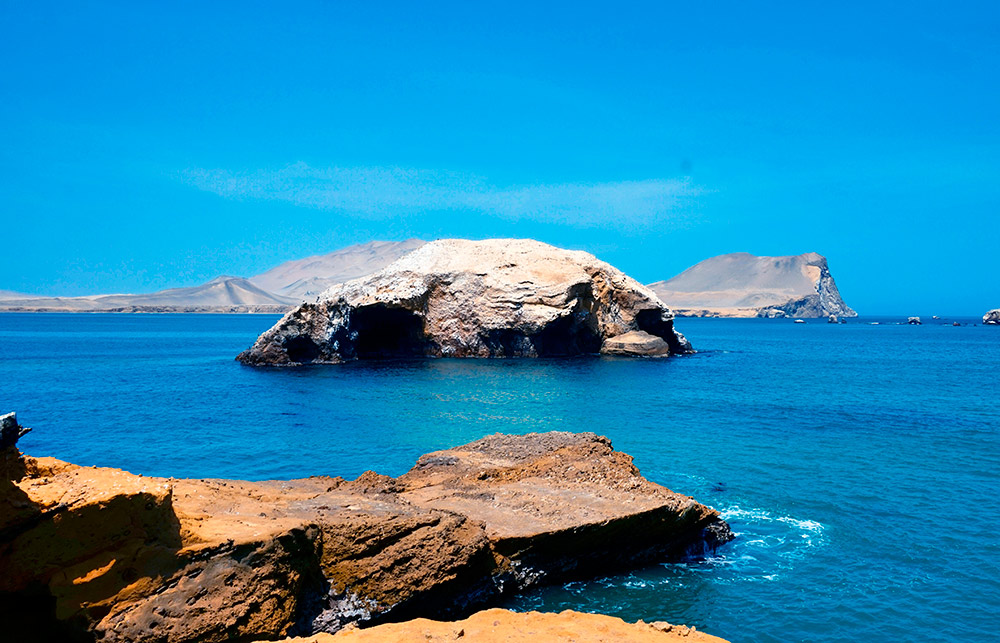位于秘鲁的帕拉卡斯国家保护区是全球最大的生态宝库之一。但如今,这片自然保护区受到了威胁,一群港口管理企业家正盘算着借道此地运输精矿。帕拉卡斯保护区的命运岌岌可危——它会得到拯救,还是会迎来毁灭?
1975年,秘鲁政府成立了帕拉卡斯国家保护区,致力“保护这个独特生态系统的自然状态”。帕拉卡斯以其丰富的野生动物资源闻名。这片土地不仅孕育了鲸鱼、海狮、海豚,能见到火烈鸟、秃鹰、企鹅等各种奇异的鸟类,还生活着少量濒临灭绝的动物,如绿海龟、海獭。

帕拉卡斯保护区不仅是生物多样性丰富的自然天堂,还保存着帕拉卡斯文化的考古遗产。帕拉卡斯文化是美洲最著名的前哥伦布文明之一,世界上的许多知名博物馆都藏有该文明的古代纺织品。这些特色使帕拉卡斯成为了秘鲁第二受欢迎的旅游胜地,仅次于库斯科的马丘比丘。帕拉卡斯也得到了国际社会的认可:1992年,联合国根据《国际湿地公约》将帕拉卡斯列为了保护对象。
虽然听起来有些不可思议,但这个保护区如今正面临着危险:一家公司联盟打算通过圣马丁港运输出口铜和锌精矿,并且已经取得了政府授予的港口特许使用权。而圣马丁港位于帕拉卡斯湾,地处帕拉卡斯保护区的“缓冲带”。

缓冲带与保护区相邻或紧邻。根据秘鲁法律,这些地带享有特殊待遇,需要遵守特殊限制,以便为周边的保护区增添额外的保护。然而在2014年,秘鲁政府举行了一场圣马丁港招标,力图推进港口现代化,而非尽可能降低港口对缓冲带的影响。批评人士认为,政府此举违反了相关法律。
由西班牙Servinoga公司和巴西Pattac公司、Tucumann公司组成的公司联盟赢得招标,拿到了合同,目前正通过Terminal Portuario Paracas公司(TPP)管理圣马丁港。其中,Servinoga公司专门从事海运贸易,Pattac公司、Tucumann公司则侧重物流运营和港口码头。
最初,监管机构对TPP公司的环境影响评估(EIA)提出了多项异议,认为EIA无法证明TPP公司不会对帕拉卡斯保护区造成不可逆的破坏,并因此禁止了圣马丁港的运营。2016年,佩德罗•巴勃罗•库琴斯基赢得秘鲁总统大选后,虽然TPP公司并未根据此前监管机构提出的异议进行改正调整,但政府依然批准了TPP公司的EIA。两年后,也就是2018年,TPP公司决定申请修改EIA,以便处理和出口矿产。由于圣马丁港没有其他进入通道,这些矿产运输时必须直接穿过帕拉卡斯保护区。
2019年,秘鲁全国可持续投资环境认证服务局(Senace)拒绝了TPP公司的申请,但公司对此提起了上诉。未来几天,该部门需要就是否批准或拒绝TPP公司的新EIA作出裁决。
TPP公司的新EIA提出要建设一处精矿贮存区。公司声称,他们会利用技术避免一切形式的污染,如密封容器、密封卡车和负压贮存。然而,仅穿行重型车流增加这一项(每年将有多达1.3万辆满载精矿石的卡车穿过保护区),就必然会对保护区造成噪音和视觉污染。新EIA也会增加物质污染风险,只要一辆卡车发生事故或翻车,环境就有可能受到污染。事实上,该地区风速高达每小时100公里(每小时62英里),此前就已经出现过类似的事故。而且,铜和锌精矿对海洋生物具有很高的毒性,一旦泄露进入水中就会造成非常可怕的后果。
不幸的是,即使到了2020年,一些人仍然拒绝理解并非所有地理区域都可以开展工业和采矿活动。事实上,自然保护区就无法开展此类活动。
如果我们想开始保护自然,我们应该号召全世界公民团结起来,更有效地保护我们的自然保护区——无论秘鲁、芬兰还是苏丹,保护自然没有国界,也不分国籍。如果说有什么能超越国籍和经济状况,把所有人都团结起来,那应该是我们对自然保护区的尊重。这份尊重提醒着我们,人类与自然仍有和平相处的希望和余地。(财富中文网)
曼纽尔•巴特拉是一位常驻秘鲁利马的律师和活动家,同时也为独立新闻网站La Mula撰写专栏。
译者:Shog
位于秘鲁的帕拉卡斯国家保护区是全球最大的生态宝库之一。但如今,这片自然保护区受到了威胁,一群港口管理企业家正盘算着借道此地运输精矿。帕拉卡斯保护区的命运岌岌可危——它会得到拯救,还是会迎来毁灭?
1975年,秘鲁政府成立了帕拉卡斯国家保护区,致力“保护这个独特生态系统的自然状态”。帕拉卡斯以其丰富的野生动物资源闻名。这片土地不仅孕育了鲸鱼、海狮、海豚,能见到火烈鸟、秃鹰、企鹅等各种奇异的鸟类,还生活着少量濒临灭绝的动物,如绿海龟、海獭。
帕拉卡斯保护区不仅是生物多样性丰富的自然天堂,还保存着帕拉卡斯文化的考古遗产。帕拉卡斯文化是美洲最著名的前哥伦布文明之一,世界上的许多知名博物馆都藏有该文明的古代纺织品。这些特色使帕拉卡斯成为了秘鲁第二受欢迎的旅游胜地,仅次于库斯科的马丘比丘。帕拉卡斯也得到了国际社会的认可:1992年,联合国根据《国际湿地公约》将帕拉卡斯列为了保护对象。
虽然听起来有些不可思议,但这个保护区如今正面临着危险:一家公司联盟打算通过圣马丁港运输出口铜和锌精矿,并且已经取得了政府授予的港口特许使用权。而圣马丁港位于帕拉卡斯湾,地处帕拉卡斯保护区的“缓冲带”。
缓冲带与保护区相邻或紧邻。根据秘鲁法律,这些地带享有特殊待遇,需要遵守特殊限制,以便为周边的保护区增添额外的保护。然而在2014年,秘鲁政府举行了一场圣马丁港招标,力图推进港口现代化,而非尽可能降低港口对缓冲带的影响。批评人士认为,政府此举违反了相关法律。
由西班牙Servinoga公司和巴西Pattac公司、Tucumann公司组成的公司联盟赢得招标,拿到了合同,目前正通过Terminal Portuario Paracas公司(TPP)管理圣马丁港。其中,Servinoga公司专门从事海运贸易,Pattac公司、Tucumann公司则侧重物流运营和港口码头。
最初,监管机构对TPP公司的环境影响评估(EIA)提出了多项异议,认为EIA无法证明TPP公司不会对帕拉卡斯保护区造成不可逆的破坏,并因此禁止了圣马丁港的运营。2016年,佩德罗•巴勃罗•库琴斯基赢得秘鲁总统大选后,虽然TPP公司并未根据此前监管机构提出的异议进行改正调整,但政府依然批准了TPP公司的EIA。两年后,也就是2018年,TPP公司决定申请修改EIA,以便处理和出口矿产。由于圣马丁港没有其他进入通道,这些矿产运输时必须直接穿过帕拉卡斯保护区。
2019年,秘鲁全国可持续投资环境认证服务局(Senace)拒绝了TPP公司的申请,但公司对此提起了上诉。未来几天,该部门需要就是否批准或拒绝TPP公司的新EIA作出裁决。
TPP公司的新EIA提出要建设一处精矿贮存区。公司声称,他们会利用技术避免一切形式的污染,如密封容器、密封卡车和负压贮存。然而,仅穿行重型车流增加这一项(每年将有多达1.3万辆满载精矿石的卡车穿过保护区),就必然会对保护区造成噪音和视觉污染。新EIA也会增加物质污染风险,只要一辆卡车发生事故或翻车,环境就有可能受到污染。事实上,该地区风速高达每小时100公里(每小时62英里),此前就已经出现过类似的事故。而且,铜和锌精矿对海洋生物具有很高的毒性,一旦泄露进入水中就会造成非常可怕的后果。
不幸的是,即使到了2020年,一些人仍然拒绝理解并非所有地理区域都可以开展工业和采矿活动。事实上,自然保护区就无法开展此类活动。
如果我们想开始保护自然,我们应该号召全世界公民团结起来,更有效地保护我们的自然保护区——无论秘鲁、芬兰还是苏丹,保护自然没有国界,也不分国籍。如果说有什么能超越国籍和经济状况,把所有人都团结起来,那应该是我们对自然保护区的尊重。这份尊重提醒着我们,人类与自然仍有和平相处的希望和余地。(财富中文网)
曼纽尔•巴特拉是一位常驻秘鲁利马的律师和活动家,同时也为独立新闻网站La Mula撰写专栏。
译者:Shog
Peru’s Paracas National Reserve, one of the world’s greatest ecological treasures, is under threat from a group of port management entrepreneurs who are seeking to transport ore concentrate through this protected natural area. The fate of the Paracas Reserve—its salvation or imminent destruction—is at stake.
In 1975, the Peruvian government established the Paracas National Reserve in an effort to “conserve the natural state” of this one-of-a-kind ecosystem. Paracas is known for its wealth of wild fauna, including whales, sea lions, dolphins, and a variety of exotic birds such as flamingos, condors, and penguins, as well as for a handful of animals in danger of extinction, including the green sea turtle and the sea otter.
But the Paracas Reserve is not just a natural paradise in terms of biological diversity. It also protects the archaeological heritage of one of the Americas’ most noted pre-Columbian cultures, the Paracas, whose ancient textiles are on display in many of the world’s most famous museums. This range of features has made Paracas the second-most-popular tourist destination in Peru, behind only Machu Picchu in Cuzco. The Paracas is also recognized by the international community: In 1992, the United Nations designated Paracas for protection under the international convention on wetlands.
As incomprehensible as it may seem, the reserve is now in danger because of a consortium’s intention to transport and export copper and zinc concentrates via the Port of San Martín. This port, located on the Bay of Paracas in the reserve’s “buffer zone,” has been awarded by the national government in concession to the consortium.
A buffer zone is the space neighboring or immediately contiguous to the protected area. By Peruvian law, these zones are subject to special treatment and restrictions in order to provide an additional layer of protection to the areas they surround. However, in what critics argue is a violation of these laws, the Peruvian government carried out a tender process in 2014 for the Port of San Martín with the goal of modernizing it, rather than keeping its impact to a bare minimum.
In this tender process, the contract was awarded to a consortium consisting of the Spanish company Servinoga, which specializes in maritime trade, and the Brazilian companies Pattac and Tucumann, which focus on logistic operations and port terminals. This consortium currently manages the port via the company Terminal Portuario Paracas (TPP).
The port was initially prevented from operating after regulatory agencies raised multiple objections to TPP’s Environmental Impact Assessment (EIA), which was unable to prove that no irreversible damages would be caused to the Paracas Reserve. After Pedro Pablo Kuczynski won Peru’s presidential election in 2016, the EIA was approved, despite the fact that the objections raised at that time had not been rectified. Two years later, in 2018, TPP decided to request an amendment to its EIA so that it could handle and export minerals, which would have to be transported directly through the Paracas Reserve due to the absence of any other possible way of accessing the port.
In 2019, the Peruvian environmental authority (Senace) rejected the request, but TPP appealed the decision. In the coming days, this authority will be required to issue its ruling on whether or not to approve or reject the new EIA, which includes the construction of an Ore Concentrate Storage Area.
TPP claims that they will use technology that would avoid any kind of pollution (e.g. closed containers, hermetic trucks, and storage with negative pressure). But the mere increase in heavyweight vehicle traffic through the reserve—through which up to 13,000 trucks full of ore concentrate would drive each year—already represents an undeniable source of noise and visual pollution. Greater still is the risk of contamination in the event that one of these trucks is involved in an accident or overturns. Indeed, such cases have already been reported in the zone, where winds blow at speeds of up to 100 kilometers per hour (62 miles per hour). And copper and zinc ore concentrates, when discharged into water, are extremely toxic to marine life—making the potential consequences of a spill very dire.
It is unfortunate that even today, in the year 2020, some people still refuse to understand that industrial and mining activities cannot take place in any and all geographic areas. Indeed, it is precisely places like natural reserves that must represent one of the limits to such activities.
If we want to start protecting nature, whether in Peru, Finland, or Sudan, it is time for the citizens of the world to come together and more effectively defend our natural reserves, which recognize no boundaries or passports. If there is something that unites us, regardless of our nationality or our economic status, it should be our respect for those natural sanctuaries that remind us that there is still hope and room for balance between human beings and nature.
Manuel Bartra is a lawyer and activist based in Lima, Peru. He is also a columnist for the online independent journalism platform La Mula.






